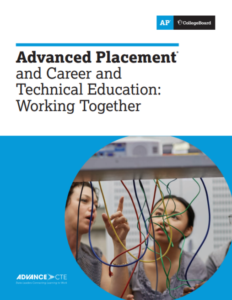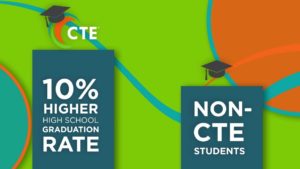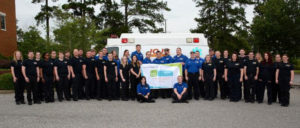Our friends at Bellwether Education Partners provide some tips for education leaders from two of our Excellence in Action award winning schools. Thank you to Kirsten Schmitz who wrote the article below!
Career Technical Education (CTE) is having something of a moment. An October Brookings report found that media mentions of the term, which commonly refers to programs teaching specific career-oriented and technical skills, have quadrupled in the past four years, and in 2015, 39 states instituted new CTE-related policies, many of which increased program funding.
While researching high-performing CTE programs, I was able to connect with two school leaders: Earl Moore, principal of Highlands, New Jersey’s Marine Academy of Science and Technology (M.A.S.T), and Jeff Brown, principal of Strathmore, California’s Harmony Magnet Academy. Both schools have a STEM focus, and while the institutions have their differences, four shared lessons emerged:
1. Career Technical Education isn’t what it used to be — we’ve come a long way
When I think about vocational programs, I immediately visualize my own eighth grade shop class. It was a six week crash course — a literal crash, we hung drywall and then smashed it to patch it — and while I took away some foundational hammering and sanding skills, the background wasn’t connected to my eventual career aspirations.
But that’s not what many of today’s CTE programs look like, and it’s certainly not the case at M.A.S.T. or Harmony. In recent years, Harmony has added a student-run enterprise program, courses in biomedicine, and a summer coding camp targeting young women. Brown spoke to Harmony’s engineering program’s constant innovation cycle: “We’re always pushing the envelope to develop new opportunities for students; we’re constantly working to find a new way to make it more real.” Moore credited his school’s success to its ability to reinvent itself: “M.A.S.T. today is not what it was in 1981…the key to a successful CTE program is the ability to change with the times.”
2. Get you a program that does both — combining an academic core with STEM-centered courses prepares students for high-value jobs after college graduation
Both M.A.S.T. and Harmony pair traditional academic core classes with CTE-specific coursework. Both leaders found integrating a technical curriculum with a college prep foundation to be especially powerful. “Teaching academic subjects through a technical lens provides immediate opportunities for application, and students really learn at a higher level. We can’t be just a school,” says Brown. M.A.S.T. also combines CTE-specific experiences with traditional academies. All students take four years of Math, English, Social Studies, and Naval Science, but they also have the opportunity to learn on a 65-foot research vessel called the “Blue Sea.” In addition, all M.A.S.T. students participate in the Naval Junior Reserve Officer Training Corps.
3. Teacher preparation and professional development matter more than ever
Just as CTE has changed over time, how we teach it has changed, too. It’s critical for teacher preparation and development to evolve with the field. Moore links his staff’s ability to prepare M.A.S.T. students appropriately to an increase in ongoing professional development offered at the school and an awareness of the constantly changing skills and knowledge industry leaders are prioritizing, which are reinforced through partnerships with local businesses. “It’s an investment in money and resources,” he says, “but you need to give educators the professional development they need to achieve the goals of the program.”
4. It takes a village — and also local businesses — to get it right
No school is an island — not even a marine sciences academy. Both Brown and Moore underscored the support of local industry and community partners, from college professors to government officials, in developing their curriculum to align with workforce needs. Says Moore, “Vocational schools really need to be in tune with their local businesses.”
Region-specific programs can foster mutually beneficial relationships. Student interns are both learning and contributing to their community.
Researchers found high school CTE participants are more likely to graduate on time and less likely to drop out than students who do not take CTE courses. At the same time, some policymakers voice concerns around equity and access, as well as wide variation in CTE program quality. There’s a lot to unpack, but programs like M.A.S.T. and Harmony show positive student outcomes using hybrid vocational and academic curriculum are possible.
 Advanced Placement® (AP) and Career Technical Education (CTE) courses can and should work in tandem to support career readiness by encouraging the development of the academic knowledge and technical skills that are, together, increasingly important to students’ overall employability. For too long, “college-ready” and “career-ready” coursework and experiences have been viewed as separate in schools. With an estimated 65 percent of jobs in the economy requiring postsecondary education and training beyond high school by 2020, schools should promote college and career readiness.
Advanced Placement® (AP) and Career Technical Education (CTE) courses can and should work in tandem to support career readiness by encouraging the development of the academic knowledge and technical skills that are, together, increasingly important to students’ overall employability. For too long, “college-ready” and “career-ready” coursework and experiences have been viewed as separate in schools. With an estimated 65 percent of jobs in the economy requiring postsecondary education and training beyond high school by 2020, schools should promote college and career readiness.

 Throughout history, and continuing today, learners of color, low-income learners, female learners and learners with disabilities have been historically tracked into terminal vocational programs leading to jobs with uncertain promise of economic growth and prosperity. While the quality of CTE programs has significantly improved since then, many of these same learners cannot access high-quality CTE programs of study that prepare them for success in postsecondary education and their future careers.
Throughout history, and continuing today, learners of color, low-income learners, female learners and learners with disabilities have been historically tracked into terminal vocational programs leading to jobs with uncertain promise of economic growth and prosperity. While the quality of CTE programs has significantly improved since then, many of these same learners cannot access high-quality CTE programs of study that prepare them for success in postsecondary education and their future careers. The
The  Earlier this summer, Advance CTE in partnership with Education Strategy Group (ESG) and the Council of Chief State School Officers (CCSSO), released
Earlier this summer, Advance CTE in partnership with Education Strategy Group (ESG) and the Council of Chief State School Officers (CCSSO), released 
 Some states have involved Career Technical Education (CTE) from the onset and others are now looking to ensure CTE is part of their overall strategy. The
Some states have involved Career Technical Education (CTE) from the onset and others are now looking to ensure CTE is part of their overall strategy. The 
 Technical Education (EMTE) program at Jones County Junior College, located in rural Ellisville, MS exemplifies excellence. All learning – in the classroom and workplace – is facilitated by knowledgeable experts leading to program graduates prepared in Health Science careers in areas of critical shortage in rural Southeast Mississippi.
Technical Education (EMTE) program at Jones County Junior College, located in rural Ellisville, MS exemplifies excellence. All learning – in the classroom and workplace – is facilitated by knowledgeable experts leading to program graduates prepared in Health Science careers in areas of critical shortage in rural Southeast Mississippi.